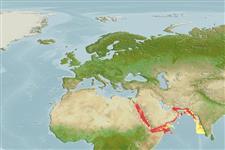Common names from other countries
Elasmobranchii (tubarões e raias) (sharks and rays) >
Carcharhiniformes (Ground sharks) >
Triakidae (Houndsharks) > Galeorhininae
Etymology: Iago: Name of villain in Shakespeare’s Othello, because members of this genus have been a “troublemaker for systematists and hence a kind of villain”. (See ETYFish); omanensis: -ensis, Latin suffix denoting place: Gulf of Oman, type locality. (See ETYFish).
More on author: Norman.
Environment: milieu / climate zone / depth range / distribution range
Ecologia
marinhas batidemersal; intervalo de profundidade 110 - 2195 m (Ref. 244). Deep-water; 30°N - 10°N
Western Indian Ocean: Red Sea, Gulf of Aqaba (Ref. 9942) and Gulf of Oman to Pakistan and southwestern India. A low-finned, somewhat short-headed Iago is largely sympatric with Iago omanensis at least off southwestern India, and in the Bay of Bengal there is possibly a dwarf, omanensis-like Iago that may or may not be distinct.
Length at first maturity / Tamanho / Peso / Idade
Maturity: Lm 55.7 range ? - ? cm
Max length : 37.0 cm TL macho/indeterminado; (Ref. 244); 58.0 cm TL (female)
Descrição breve
Chaves de identificação | Morfologia | Morfometria
Brown or grey dorsally, lighter below; dorsal and caudal fins may have darker tips and leading edges (Ref. 5485).
Found on the continental shelf and slope. Water temperature: 16-25°C. Oxygen level: 0.2-2.4 ppm. Feeds on bony fishes (mostly lanternfishes) and cephalopods. Sexual dimorphism by size exists. Viviparous (with a yolk-sac placenta), with probably 2 to 10 young in a litter. Utilized fresh for human consumption.
Viviparous, placental (Ref. 50449). Distinct pairing with embrace (Ref. 205).
Compagno, L.J.V., 1984. FAO Species Catalogue. Vol. 4. Sharks of the world. An annotated and illustrated catalogue of shark species known to date. Part 2 - Carcharhiniformes. FAO Fish. Synop. 125(4/2):251-655. Rome: FAO. (Ref. 244)
Categoria na Lista Vermelha da IUCN (Ref. 130435)
CITES (Ref. 128078)
Not Evaluated
Ameaça para o homem
Harmless
Utilização humana
Pescarias: pescarias de subsistência
Ferramentas
Relatórios especiais
Descarregue XML
Fontes da internet
Estimates based on models
Preferred temperature (Ref.
115969): 10 - 21.7, mean 14.6 (based on 100 cells).
Phylogenetic diversity index (Ref.
82804): PD
50 = 0.7500 [Uniqueness, from 0.5 = low to 2.0 = high].
Bayesian length-weight: a=0.00427 (0.00183 - 0.00992), b=3.04 (2.83 - 3.25), in cm Total Length, based on LWR estimates for this (Sub)family-body shape (Ref.
93245).
Nível Trófico (Ref.
69278): 4.2 ±0.3 se; based on diet studies.
Resiliência (Ref.
120179): Muito baixo, tempo mínimo de duplicação da população maior que 14 anos (K=0.48; Fec=2).
Fishing Vulnerability (Ref.
59153): Moderate vulnerability (43 of 100).
